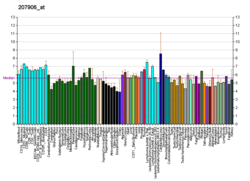Function
Interleukin 3 is an interleukin, a type of biological signal (cytokine) that can improve the body's natural response to disease as part of the immune system. [10] In conjunction with other β common chain cytokines GM-CSF and IL-5, IL-3 works to regulate the inflammatory response in order to clear pathogens by changing the abundance of various cell populations via binding at the interleukin-3 receptor. [9] [10]
IL-3 is mainly produced by activated T cells with the goal of initiating proliferation of various other immune cell types. [8] However, IL-3 has also been shown to be produced in IgG+ B cells and may be involved in earlier antibody isotype switching. [9] IL-3 is capable of stimulating differentiation of immature myelomonocytic cells causing changes to the macrophage and granulocyte populations. [8] IL-3 signaling is able to give rise to widest array of cell lineages which is why it has been independently named "multi-CSF" in some older literature. [10]
IL-3 also induces various effector functions in both immature and mature cells that more precisely modulate the body's defense against microbial pathogens. [8] [10] IL-3 is also involved in the reconstruction of platelets via the development of megakaryocytes. [10]
Interleukin 3 stimulates the differentiation of multipotent hematopoietic stem cells into myeloid progenitor cells or, with the addition of IL-7, into lymphoid progenitor cells. In addition, IL-3 stimulates proliferation of all cells in the myeloid lineage (granulocytes, monocytes, and dendritic cells), in conjunction with other cytokines, e.g., Erythropoietin (EPO), Granulocyte macrophage colony-stimulating factor (GM-CSF), and IL-6.
IL-3 is secreted by basophils and activated T cells to support growth and differentiation of T cells from the bone marrow in an immune response. Activated T cells can either induce their own proliferation and differentiation (autocrine signaling), or that of other T cells (paracrine signaling) – both involve IL-2 binding to the IL-2 receptor on T cells (upregulated upon cell activation, under the induction of macrophage-secreted IL-1). The human IL-3 gene encodes a protein 152 amino acids long, and the naturally occurring IL-3 is glycosylated. The human IL-3 gene is located on chromosome 5, only 9 kilobases from the GM-CSF gene, and its function is quite similar to GM-CSF.
Receptor
IL-3 is a T cell-derived, pluripotent and hematopoietic factor required for survival and proliferation of hematopoietic progenitor cells. The signal transmission is ensured by high affinity between cell surface interleukin-3 receptor and IL-3. [11] This high affinity receptor contains α and β subunits. IL-3 shares the β subunit with IL-5 and granulocyte-macrophage colony-stimulating factor (GM-CSF). [12] This β subunit sharing explains the biological functional similarities of different hematopoietic growth factors. [13]
IL-3 receptors can be found on a variety of cell types including many immature myelomonocytic cells in the hemopoietic system such as hemopoietic progenitor cells, as well as certain myeloid progenitors, basophils, and eosinophils. [10]
IL-3/Receptor complex induces JAK2/STAT5 cell signalization pathway. [8] It can stimulate transcription factor c‑myc (activation of gene expression) and Ras pathway (suppression of apoptosis). [5]
Immunological therapy
Human IL-3 was first cloned in 1986 and since then clinical trials are ongoing. [16] Post-chemotherapy, IL-3 application reduces chemotherapy delays and promotes regeneration of granulocytes and platelets. However, only IL-3 treatment in bone marrow failure disorders such as myelodysplastic syndrome (MDS) and aplastic anemia (AA) was disappointing. [13]
It has been shown that combination of IL-3, GM-CSF and stem cell factor enhances peripheral blood stem cells during high-dose chemotherapy. [17] [18]
Other studies showed that IL-3 could be a future perspective therapeutic agent in lymphohematopoietic disorders and solid cancers. [19]
This page is based on this
Wikipedia article Text is available under the
CC BY-SA 4.0 license; additional terms may apply.
Images, videos and audio are available under their respective licenses.


